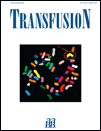Implication of transfected cell lines for the detection of alloantibodies against human neutrophil antigen-3
Abstract
BACKGROUND: Alloantibodies against human neutrophil antigen-3 (HNA-3) are responsible for the fatalities reported in transfusion-related acute lung injury. Consequently, reliable detection of these alloantibodies is mandatory to improve blood transfusion safety. In this study, we developed stable cell lines for the detection of HNA-3 antibodies.
STUDY DESIGN AND METHODS: HEK293T were transfected with HNA-3a or HNA-3b constructs and sorted by flow cytometry according to high surface expression. Transfected cells were tested with sera containing HNA-3 antibodies in flow cytometry and antibody capture assay (ACA). The results were compared with granulocyte agglutination test and granulocyte immunofluorescence test.
RESULTS: In flow cytometry, 12 of 14 HNA-3a sera reacted specifically with HNA-3aa cells. One serum sample showed positive reaction with HNA-3bb cells. All HNA-3b sera recognized HNA-3bb cells. No reaction was observed with broad reactive antibodies against HLA Class I. In ACA, all HNA-3a sera (12/12) showed positive reactivity with HNA-3aa cells with no cross-reactivity with HNA-3bb cells. Again, all HNA-3b sera reacted with HNA-3bb cells only. Furthermore, genotyping of 249 individuals detected a new HNA-3 allele caused by a nucleotide substitution C>T at Position 457 leading to L153F mutation in choline transporter-like protein-2. This mutation impairs polymerase chain reaction with sequence-specific primers based HNA-3a typing. However, analysis with cells expressing F153 isoform showed that this mutation did not alter the binding of HNA-3 antibodies.
CONCLUSIONS: This study demonstrated that HEK293T cells expressing stable recombinant HNA-3 are suitable for the detection of HNA-3 alloantibodies allowing reliable screening of blood products.




